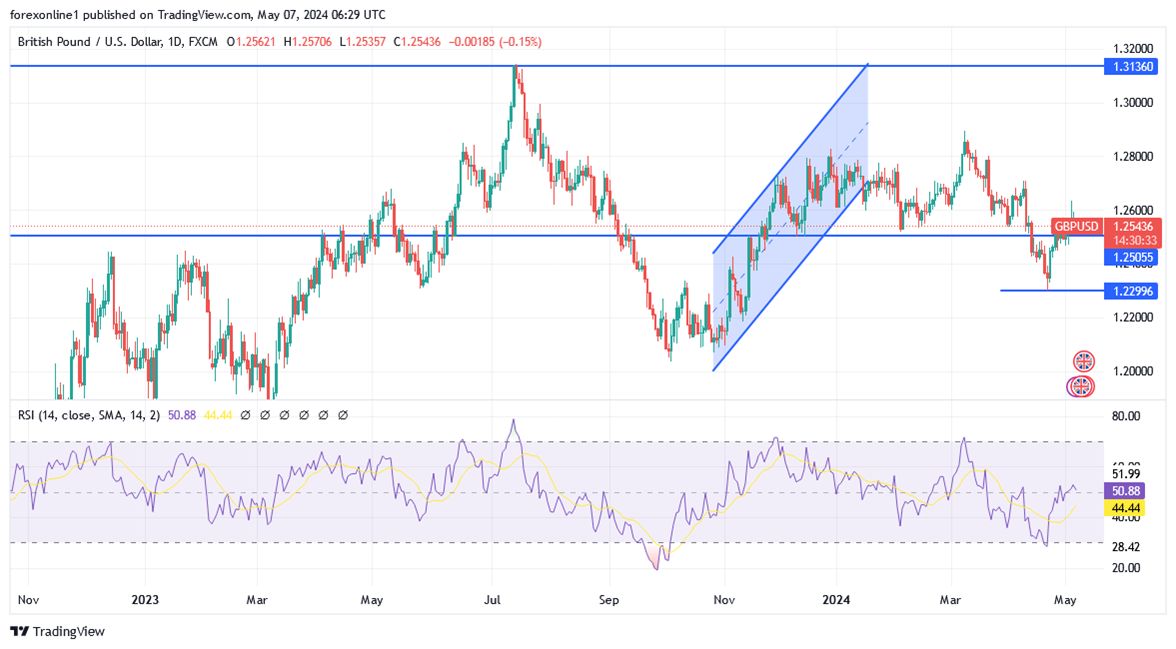- The late week decline in the GBP/USD exchange rate is an ominous sign and suggests potential losses in the coming days.
- According to forex trading platforms, the pound joined its G10 peers in rising in the aftermath of Friday's weaker-than-expected US jobs report - a weaker-than-expected US jobs report that raised the odds of the Fed cutting rates before December.

According to trading, the GBP/USD exchange rate rose to just above 1.26 but quickly fell back to pre-job print levels. This comes despite other currencies holding their gains against the dollar, immediately signaling the pound's weakness.
Meanwhile, this tells us that the market is nervous that the Bank of England will see the slowdown in the US jobs market as the cover it needs to shift to ease monetary policy and cut interest rates sooner rather than later. For his part, both Governor Bailey and his deputy, Dave Ramsden, indicated last month that they believe that the battle against inflation has been won, and that they can begin cutting interest rates before inflation numbers actually confirm this outcome.
Ideally, the bank would like to cut alongside other global central banks to minimize financial volatility, especially exchange rate volatility (as early cuts risk lowering the value of their currencies). Overall, the weak US jobs report increases the scope for the Fed to cut rates sooner, and markets are betting that this will affect the BoE's thinking. In short, what is considered bearish for the dollar is also bearish for the pound.
Commenting on the most important event for the pound this week, the Bank of England's announcement, Paul Robson, currency analyst at NatWest Markets, says that the clearest risk to the pound would be if markets eventually move to price in NatWest's base case of a 100-basis point rate cut this year. At the time of writing, the market was pricing in about half of that amount.
A note from Barclays' forex research team adds: "The pound is at risk from the BoE at its May 9 meeting." And "The MPC is gradually shifting to a more dovish tone, as evidenced by Ramsden's recent speech but also Governor Bailey's more nuanced comments at the IMF meetings."
Top Forex Brokers
What most economists agree on is the degree of difference in views regarding the Monetary Policy Committee. Now, there is a whole host of thinkers, with Swati Dhingra having long called for lower interest rates, while two members only abandoned their call for further rate hikes in March. Recently, the comments showed that even centrists are divided (chief economist Hugh Bell wants to wait longer, while Conservative Andrew Bailey and Deputy Conservative Dave Ramsden appear ready to cut rates).
Andrew Goodwin, Chief UK Economist at Oxford Economics, says: "After voting as a bloc in recent years, the five internal members seem less united than before." Analysts at Credit Agricole added, "The BoE's outlook is somewhat opaquer, as the MPC appears to be more divided on the need for early rate cuts."
Clearly, this means that there will be “new news” about UK interest rate expectations next Thursday, and the “new news” could move the currency markets.
Additionally, when we think about a bullish scenario for sterling, we imagine that this will involve the Bank doing its best to point out that not much has changed, and that although it is satisfied with the progress regarding inflation, it remains cautious. Consequently, this may reinforce expectations of a rate cut in August. Here we imagine that the British pound is recovering from its highest levels in May last Friday, and the size of any recovery depends on the depth of the ongoing selling operations in the near term.
This week will be busy from the point of view of the Fed's rate expectations, which is of course the main driver of GBP/USD. On this front, we have a line-up of Fed speakers lined up to give their views on the latest data and what they think it means for the policy outlook. Hence, this could provide some volatility and cause some disruption. Eventually, the most important full releases will not be released until mid-month, the most prominent of which is inflation.
Technical forecasts for the GBP/USD pair today:
According to forex market trading, we were on the verge of declaring the end of the bearish trend for the British pound in 2024 when it broke above the downward trend line on Friday. However, the subsequent failure to sustain the rise means this could be a false breakout, and if the GBP/USD price falls back below the trend line in the coming days, it could rise to 1.22 in May, historically a very bad month for this exchange rate.
At the time the image was taken on the chart, the exchange rate had actually fallen below the 200-day moving average, indicating that an area of massive resistance may be thwarting the uptrend. Our forecast rule for this week is that while the exchange rate is below 200 DMA in a downward trend, while above it there is an upward trend.
Perhaps, the market just needs more information before reversing the trend. A significant portion of this information will be provided next Thursday when the Bank of England presents its latest guidance and forecasts regarding interest rates, which may confirm a preference for a rate cut in June. Ultimately, this means that further repricing will be needed in UK bond markets, to the detriment of sterling.
Ready to trade our daily Forex analysis? Check out the best forex trading company in UK worth using.
